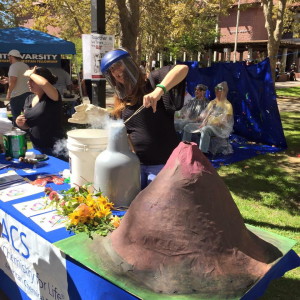On September 24, 2015, the SCC Chemistry Club amazed the students of Sacramento City College yet again with the SCC ACS Chemistry Club booth at SCC Student Club Day. The Chem Club had 2 demonstrations for display and a chemistry trivia corner where students answered science questions to win prizes of candy or chemistry moles.

Nicole Ackerman, SCC Chem Club Vice President, dips a flower in liquid nitrogen. The volcano awaits an eruption!
The main demonstration of the Chem Club booth was the Baking Soda Volcano, built by Ryan Johnson, one of our Chem Club members. The Baking Soda Volcano is a classic demonstration of an acid-base reaction. For the Baking Soda Volcano demonstration, warm water, dish detergent, and baking soda are placed inside the volcano. In order to create an “eruption”, vinegar is then poured inside the volcano and from there, the resulting “lava” pours out of the volcano.
The reaction of the Baking Soda Volcano is an acid-base reaction. The baking soda, which is sodium bicarbonate, acts as a base in this reaction whereas the vinegar, or acetic acid, as an acid. When adding the acetic acid to sodium bicarbonate, the acetic acid reacts with the sodium bicarbonate and neutralizes the sodium bicarbonate. One of the products from this acid-base reaction is the carbon dioxide gas, which is what causes the fizzing and the bubbling of the volcano “eruption”. The “lava” that flows out of the volcano is a dilute solution of sodium acetate and water, which are the other products of the acid-base reaction.
The other demonstration that the Chem Club had at the booth was the Liquid Nitrogen demonstration. In this demonstration, the demonstrator and students take an array of objects, such as, flowers and safely (and under supervision of the club’s advisor, Bill Miller) place the objects in liquid nitrogen for a few seconds, remove the object from the liquid nitrogen and see the results of their now frozen object. The object, in this case, a flower, is now frozen when placed in the liquid nitrogen because the liquid nitrogen freezes the water inside the flower since water freezes at 0°C and liquid nitrogen boils at -196°C.
The booth, along with the mentioned demonstrations, had the local Sacramento ACS stickers, pins, and fliers with information about the SCC ACS Chemistry Club.
